In ministry, every person matters. And in a large church, keeping track of every person and their journey can feel overwhelming—unless your tools are working for you, not against you. That’s where an integrated church management system (ChMS) plays a pivotal role. But if your system is fragmented or your data lives in multiple places, your ministry could be missing out on transformational insights.
What Are Data Silos In Ministry?

Silos are useful on farms. They store grain in neat, separated spaces. But when it comes to church data, silos are a liability.
While most of us may be familiar with the term “data silo” or have at least heard our team taking about it, it may be helpful for a quick refresher:
A data silo happens when information is isolated in separate systems or departments. Each ministry team might have their own tools and processes—one team’s tracking volunteers with spreadsheets, while another manages communication in a separate app. While each solution might meet a local need, the church as a whole ends up with incomplete, disconnected data. This problem is only made worse when each software program is utilized differently by each team. Expectations on what data needs to be entered, how much training staff needs on each program, and how that information is then relayed to key leadership can become fuzzy over time.
In today’s ministry landscape, having quick and centralized access to data isn’t just convenient—it’s critical. It allows you to:
- Track Congregational Engagement In Real Time
- Understand Personal Spiritual Journeys
- Respond Quickly To Needs And Opportunities
- Strengthen Connections Across Ministries
Your data is one of your greatest listening tools. But only if it’s integrated.
How Data Silos Disrupt Church Operations
Let’s illustrate further the challenges data silos present. Here’s a real-life example from a church we recently talked to:
The Request: A church wanted to use their data to find the correlation between attendance/serving and how it directly affects their giving.
The Problem: The church has to find and compile that data from 3 different areas. Their Finance team is using one software/giving platform, their serve team is using another one, and their groups pastor is using yet a third one. Not ideal for processing information.
The Solution: Implementing an all-in-one software solution that houses all ministry data to better evaluate trends and make decisions.
Now for some churches there’s a possibility that 1 of the 3 software companies being utilized has an all-in-one solution, and the church staff just needs to make a commitment to use the same system. That’s not always the case though. There’s a reason that churches use multiple systems; it may be tolerable at first, but the larger a church gets, the more important it is to have a centralized church management system.
Helping Churches Stay Personal
From 700 to 7,000 & Beyond—We Grow With Your Ministry

The Hidden Costs Of Fragmented Church Data
Even the best intentions can fall short when your tools don’t work together. Here are three hidden costs of working with a disjointed or underperforming church management system.
1. Messy And Outdated Records
Take a moment to think about your current church data:
Is it organized? Updated? Easy to find?
Ministry is beautifully messy—we work with people, after all. But your data doesn’t have to be. Unfortunately, many churches are dealing with databases that are outdated, fragmented, and frustrating. Member records may be duplicated across tools, or worse, neglected altogether because the system is too clunky to use.
A good ChMS should bring clarity, not confusion. It should help you clean up messy data, not contribute to it.

2. Paying For Multiple Tools
When your main ChMS doesn’t meet your ministry’s needs, departments often go rogue—purchasing separate apps for volunteer management, communication, check-in, or giving. It’s an understandable workaround, but it introduces two big problems:
- Hidden Costs: Each department tool likely comes with its own subscription, adding up to a significant expense.
- Data Disconnection: These tools rarely integrate. Your people’s data becomes scattered, meaning you don’t get the full picture of their engagement or journey.
In the long run, this patchwork approach is more expensive and less effective. Data silos contribute to wasted time and dollars and can be consolidated.
3. An Incomplete Ministry Picture
When your data is incomplete or outdated, you lose the ability to see patterns, trends, and opportunities.
- Are families attending consistently?
- Who is stepping up to serve—or stepping away?
- Which events are creating the most connection?
If your leadership team can’t answer these questions confidently, your ChMS isn’t doing its job. Without complete, up-to-date data, you miss chances to deepen discipleship and create meaningful ministry moments. If you want an opportunity to close the back door and reach out to people who are disconnecting, your ChMS should aid you in identifying who to reach out to and when.
The Solution: An Integrated Church Management System
A modern ChMS should be more than a glorified directory. It should be:
- A Centralized Hub For All Ministry Data: One place to manage member records, giving history, volunteer schedules, communication, and more
- An Integrated System That Strengthens Ministry Effectiveness: Your database, mobile app, and giving platform should all feed into the same system—no syncing issues, no data gaps
- An Accessible and Intuitive Tool: Your staff and volunteers can actually use it without constant frustration
If your system isn’t providing this, it’s time to re-evaluate. The cost of data silos goes far beyond dollars. It impacts your ability to listen, respond, and disciple well.

Testimony: Church At The Mill’s Journey To Integration
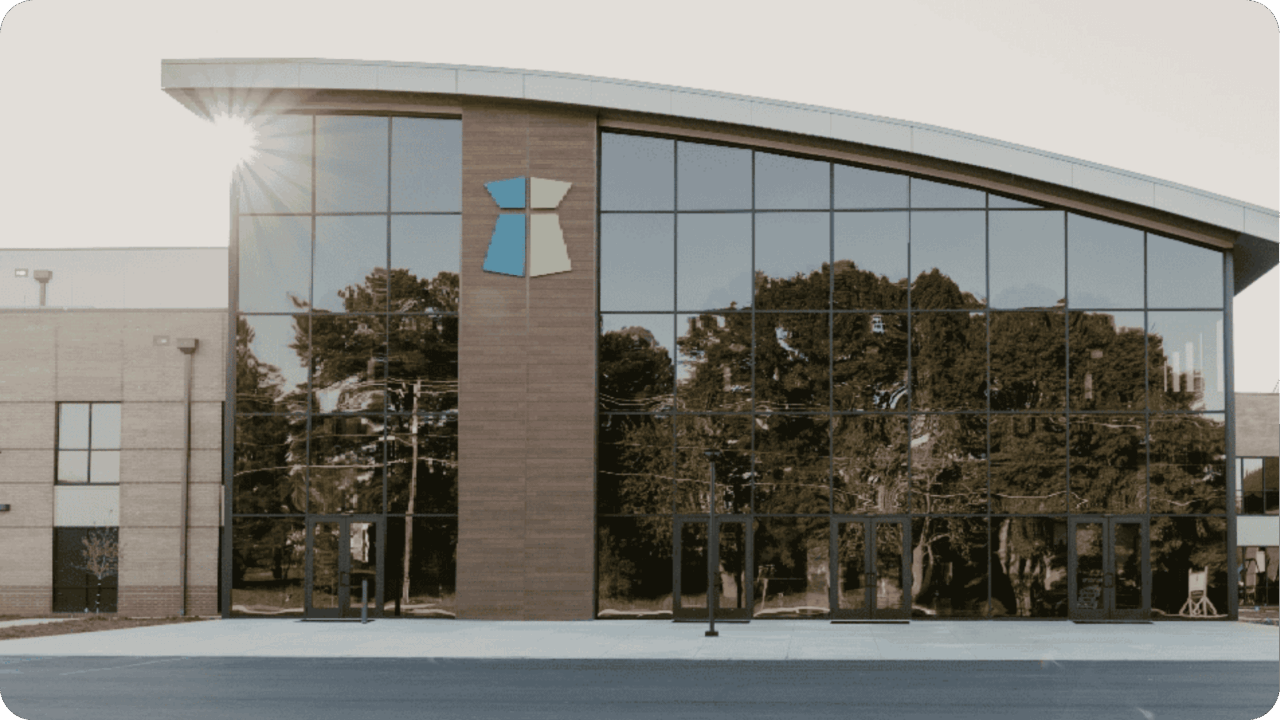
From Disconnected Systems to Unified Ministry Tools
Before implementing TouchPoint, Church At The Mill (South Carolina) was juggling numerous third-party tools including Jotform, GroupMe, Remind, Subsplash, Square, Excel, and Google Sheets. Each served a separate purpose (forms, communication, check-in, group management) but none were integrated. The result was:
- Data inaccuracies due to duplication across platforms
- Limited visibility into true congregational engagement
- Higher costs from maintaining multiple subscriptions
- Siloed ministry efforts without a holistic view of members
After consolidating these tools into the TouchPoint ecosystem, the church gained a centralized, secure, and integrated church management system for all ministry activity.
Streamlined Registration and Communication
TouchPoint eliminated the need for manual data imports and exports. Registration information is now automatically synced to the database in real time, ensuring accuracy and freeing up staff time.
Key Benefits:
- No more manual reconciliation of payments or form data
- Instant updates to member records
- Personalized follow-ups using built-in email tools
- Increased communication efficiency with automated messaging options
Smarter, Targeted Email Strategy
With TouchPoint’s integrated email functionality, Church At The Mill improved its communication in significant ways:
- Staff can segment emails based on ministries, campuses, or demographics
- Email tracking helps determine open rates and follow-up needs
- Open rates increased from ~50% to ~60%, indicating stronger engagement
- Built-in tools simplify parent-specific messaging, reducing redundancy
A Data-Driven Approach To Shepherding
One of the most transformative outcomes was how TouchPoint enhanced pastoral care:
- All involvement is measured, enabling staff to see a full picture of each person’s engagement and faith journey
- Real-time engagement insights that help identify declining participation early
- All communication touchpoints are centralized, improving collaboration across teams
- Engagement can now be trended across demographics (Kids, Students, Adults) using metrics like:
- Sunday and midweek attendance
- Small group involvement
- Serving and membership status
- Campaign-specific giving
The Heart Behind The Technology
Above all, Church At The Mill shared that their ultimate goal is to “shepherd our congregation as effectively as possible”—and having the right technology made that possible. By eliminating data silos and embracing one unified system, they were empowered to listen better, respond faster, and disciple more effectively.
Final Thoughts: Don’t Let Your Data Work Against You

You’re called to steward people, not spreadsheets. A reliable, integrated church management system empowers your church to make informed decisions, care for people holistically, and pursue your mission with clarity.
Whether your church is navigating rapid growth or simply trying to do ministry more effectively, integrated data is a key part of the solution.
Next Step: Let’s Start The Conversation
If you’re curious about how other churches are navigating this journey—or want to explore what a unified system could look like for your team—reach out and schedule a demo with the TouchPoint Team. We’d love to learn more about your ministry and share how we’re coming alongside other churches like yours.
When Broadmoor Baptist Church in Mississippi made the decision to transition away from their aging church management system, they weren’t just looking for better software—they were searching for a ministry tool that could support their growing congregation, improve data accuracy, and enhance the Sunday experience for everyone from first-time guests to seasoned members. What they found in TouchPoint was more than a platform. It was a strategic partner that empowered their vision to know and be known.
The Road To Implementation
Broadmoor is no small church. With over 5,000 members and roughly 2,000 in weekly worship attendance, the church needed a system robust enough to handle complexity while flexible enough to meet ministry-specific needs. Kathy Morgan, who brought years of software experience into her role at Broadmoor, knew from day one that their current solution wouldn’t support long-term ministry goals.
After attending TouchPoint Summit in Chicago in 2023 and evaluating other vendors, the team at Broadmoor unanimously agreed—TouchPoint wasn’t just the best option, it was the right one.
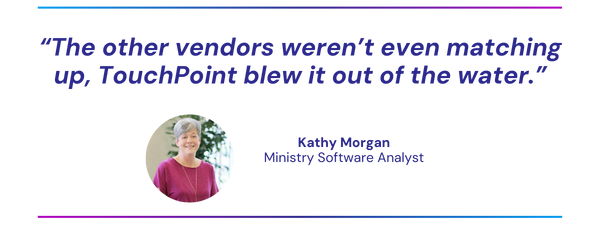
Laying The Foundation: A Culture Of Data And Ministry
One of the first major initiatives following implementation was to fully integrate TouchPoint’s Check-In functionality. But this wasn’t just about printing name tags. For Broadmoor, checking in was about reshaping the way their church family connected—with staff, with each other, and with ministry opportunities.
Michael Bowen, who oversees communications and is part of the church’s creative arts ministry, explained that building a culture of checking in started with casting vision.
“At the end of the day, it’s about ministry. Yes, it’s just a database. Yes, it’s just a tool. But if the data is accurate, it helps us make better decisions.”
The team approached implementation with intentionality: instead of training staff on a generic sandbox, they trained using real Broadmoor data. Real people, real groups, real processes. This made adoption easier and gave staff confidence that the system would support—not complicate—their workflows.
Creating A Culture Shift

The heart of Broadmoor’s Check-In success lies in its cultural transformation. Historically, Check-In was limited to next-gen ministries for security tags. But with TouchPoint, Broadmoor began encouraging every attendee to check in, regardless of age or ministry involvement.
Check-In kiosks were strategically placed at main entrances and ministry areas, and the team prioritized ease of use and reliability. They opted to hardwire all stations to prevent the risk of Wi-Fi disruptions.
In just four weeks, Broadmoor saw nearly 70% of worship attendees checking in—a staggering achievement for a church that hadn’t emphasized Check-In in over a decade. That number recently rose to 72%.
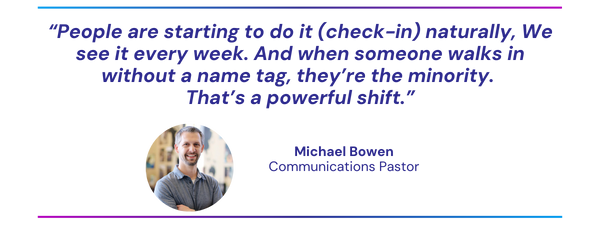
The TouchPoint Team: Personal Touch Meets Strategic Support
To reinforce checking in, Broadmoor created a “TouchPoint Team” of volunteers and staff who manned kiosks each Sunday. These team members served a dual role: helping people navigate Check-In while also capturing feedback for ongoing improvement.
As Kathy noted, even less tech-savvy members found the new system easier than the previous one—and that’s no small win.
Staff were expected to serve during key windows, which not only provided Sunday morning support but also kept leadership engaged in the process. That visibility reinforced the church’s commitment to making checking in a part of their culture, not just a task.
And for guests who weren’t in the system? They got added into the database! As Kathy described, one man who had intentionally stayed under the radar for years finally asked for a name tag. “To catch you, I need your phone number,” Kathy told him. That simple interaction showed how Check-In was bridging the gap between anonymity and belonging.
Staff Engagement And Training
What made Broadmoor’s implementation so successful wasn’t just infrastructure—it was the engagement of the entire staff. Kathy sent out a daily “My TouchPoint Tip of the Day,” helping staff learn their new church management software in bite-sized, approachable ways. From updating profiles to searching birthdays, each tip was designed to make TouchPoint approachable and practical.
To cap off training, the team organized a TouchPoint scavenger hunt—a creative, interactive way to get staff exploring the system and learning by doing.
And the results speak for themselves. More than 380 members have already updated their profiles, including photos and contact information. Members are not just passively existing in the database—they’re actively participating in its accuracy.
Moving Forward: Next Steps
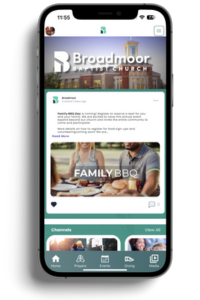
Broadmoor is already thinking ahead. Their team is exploring more efficient ways to process first-time guests, especially those who may not make it to the welcome desk. iPads with simplified forms may soon be deployed to help volunteers input guest info more quickly.
Broadmoor’s Church Branded Mobile App is also on the horizon. While it’s not live yet, the team is using this time to build anticipation and keep the momentum going. Once released, the app will add another layer of convenience, allowing families to Pre Check-In from their phones and streamline their Sunday mornings even further.
The Strategic Value Of Check-In
For Broadmoor, Check-In isn’t about tracking attendance. It’s about intentional ministry. It’s about making sure no one falls through the cracks. It’s about stewarding the people God brings through their doors.
As Michael put it, “Churches have historically made decisions based on anecdotal evidence. TouchPoint helps us be more strategic. But we had to set it up to win—it doesn’t do the work for you.”
Broadmoor Baptist’s journey with TouchPoint is a compelling example of how the right tools, paired with the right vision, can lead to cultural transformation. Their story reminds us that software isn’t just a system—it’s a ministry partner when deployed with purpose.
If you are familiar with TouchPoint registrations, you’re probably well-versed in setting limits on questions. This is a great way to ensure that registrants don’t sign up for more of any particular option than you have available. This question type is perfect for inventory control!
A less-commonly used question type, the Menu, allows you to set limits more granularly — per registrant. This allows you to ensure that everyone who wants to purchase or participate in said option is able to. It’s a great way for sharing the love!
Check out this TouchPointer to learn more about using the Menu question type with limits.
Ready To Make The Most Of TouchPoint?
This tip is just one way to make your church software work smarter for you. Our consulting team can help you discover more ways to optimize systems, streamline processes, and boost community involvement. If you’d like to explore additional TouchPoint features to enhance your church’s digital experience, reach out to us at [email protected].
Ready to share the love with your next registration form? Watch the video to see this TouchPointer tip in action, and learn how to make registrations even easier with TouchPoint!
Watch more TouchPointer videos!
It’s never too early to start preparing for Christmas, especially when it comes to managing the various aspects of church activities. Join us for our upcoming “Christmas in July” webinar on July 25th at 2 PM CST. This webinar is designed to help church leaders and staff use their church management software effectively to streamline their holiday planning.
Webinar Details:
- Date and Time: July 25th, 2 PM CST
- Speakers: Cody Binder and Sarah Cavanaugh from TouchPoint Software
- Key Topics: Utilizing your Church Management Software for Christmas planning
Key Strategies for Christmas Planning:
- Using Involvements
- Checklists
- Volunteer Sign-Ups and Schedulers
- Marketing
- Mobile App
Other Creative Ways to Use Your Church Software This Christmas Season:
- Event Registration: Simplify the process for churchgoers to sign up for special Christmas events and services.
- Communication Tools: Automate emails and text messages to keep everyone informed about upcoming events and important dates.
- Resource Management: Track all your Christmas resources, from decorations to service materials, and ensure everything is accounted for.
- Attendance Tracking: Monitor attendance at Christmas events to understand engagement and plan for future events more effectively.
- Donations and Fundraising: Set up and manage Christmas-specific fundraising campaigns, making it easy for congregants to contribute.
Why Start Now?
Planning for Christmas can be time-consuming, but it doesn’t have to be stressful. By starting early and utilizing the tools available in your church management software, you can make the process enjoyable for your staff and ensure nothing is left to the last minute.
Who Should Attend?
This webinar is perfect for church leaders, administration staff, communications teams, production crews, and worship leaders. Whether you’re already using church database software or looking for ways to improve your Christmas setup, this session is for you.
Register Today!
Don’t miss out on this opportunity to get a head start on your Christmas planning. Join our Zoom webinar on July 25th at 2 PM CST and learn from the experts. Register Now!
Not Yet A Part Of The TouchPoint Family?
Schedule a free demo from one of our friendly team members, schedule a demo!
Missed Last Month’s Webinar?
You can watch our past webinars on YouTube in our Webinars playlist!
Hi, friends!
Summit is fast approaching! This year’s event will take place from Tuesday, September 17th through Thursday, September 19th in beautiful Alabama, and it’s shaping up to be our most exciting Summit yet.
This year’s event will be packed with insightful sessions, networking opportunities, and plenty of inspiration. Whether you’re a first-time attendee or a Summit veteran, there will be something for everyone to enjoy and learn from.
But that’s not all! We are excited to share that we have already surpassed last year’s registration numbers and are on the brink of a major milestone! To make it even more exciting, we’re introducing two fun giveaways:
1. We only need four more people to register to hit 200 participants before July 1st! The 200th person who registers will win a stylish pair of Goodr Sunglasses, perfect for enjoying the Alabama sunshine during Summit! So, don’t wait—register now to secure your spot and possibly become our special 200th registrant.
2. Interested in refreshing one of your Check-In kiosks? On July 1st we will do a drawing to give away a 10th Generation iPad! Everyone who is registered before July 1st will be entered to win!
Summit is not just an event; it’s an opportunity to connect with fellow church partners, share best practices, and grow together. We can’t wait to celebrate this achievement with you and make this Summit an unforgettable experience.
Ready to join us? Head over to summit-touchpointsoftware-com.touchpoint1dev.wpengine.com to learn more and register today! Remember, only four spots are left to hit our milestone, so hurry for your chance to win those fantastic Goodr Sunglasses and to get your name added to the
We look forward to seeing you in Alabama this September!
Blessings,

In 2022, we introduced several Grade and Promotion updates to better serve our partner churches. Here’s a summary of the key changes and how they can benefit your church:
New Grade Level Dropdown
We’ve added a Grade Level dropdown in Involvement and people records. This feature includes standard grade levels and allows you to add custom levels using Lookup Codes. To enable new levels, simply change the setting named Allow New Grade Levels (Admin > Advanced > Settings > System > Administration) to True. Reports that include Grade have also been updated to reflect this new Grade field.
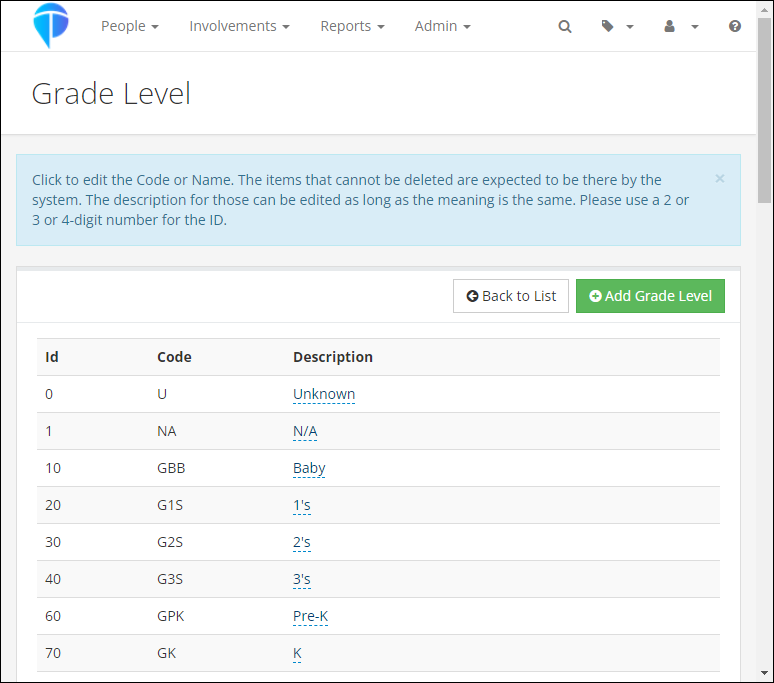
Automatic Grade Promotion
We introduced a new admin setting called Grade Update Date. This setting automatically promotes each child’s Grade Level annually. The default promotion date is set to July 1st, but you can customize it to match your church’s annual promotion schedule. Note: If you select a date prior to today, the promotion will be skipped for this year.
Legacy Grade Field
Another new admin setting, Hide Grade Legacy, allows you to hide the legacy Grade field once it’s no longer needed. Please note that we will disable the legacy Grade field for all partner churches in July 2024 if it hasn’t been done already.
As you prepare for Vacation Bible School and other summer and fall registrations, please keep the following in mind:
- Check Your Grade Update Date: Ensure this setting aligns with your church’s promotion timeline.
- Consider Registration Timing: When including the Grade question in an Involvement, consider the timing of registration versus when the Grade will be automatically updated. For example, if a registrant states they will be in 11th grade in the fall and the update happens after, they may be promoted twice.
- Adding New Members: When adding new members to your database and then to a Main Fellowship Involvement with a Grade populated on the Settings > General tab, this Grade will be added to their record. However, it won’t affect existing records with a Grade.
For more detailed information, please refer to these help articles:
Grade Field
Grade
Administrative Settings
We’re excited to remind our church partners about an important event this June. Join us for the Q2 New Features Webinar June 27th at 2 PM CST, hosted by Chris Dolan and Hayley Whitworth. This session will cover the latest updates, including new mobile features, finance rollouts, and more.
What to Expect
In this webinar, Chris and Hayley will walk you through the latest updates and enhancements. Whether you’re a seasoned user or new to our system, this session is packed with valuable information to help you make the most of these new features.
Why You Should Attend
- New Features: Learn about the latest mobile updates, finance tools, and other features designed to support and enhance your church’s ministries.
- Comprehensive Overview: Get a detailed look at all the new features and how they can benefit your church operations.
- Stay Informed: Keep up to date with the latest features and updates.
- Enhance Efficiency: Discover new tools and strategies to maximize productivity.
Register Today!
Don’t miss this opportunity to stay informed and connected. Register for our Q2 New Features Webinar on June 27th at 2 PM CST. We look forward to seeing you there!
Special Note
This webinar also marks Chris Dolan’s final webinar with TouchPoint as Head of Product. If you missed this announcement, you can watch the video here. We will give Chris a special send-off as he wraps up his chapter at TouchPoint.
Maintaining efficient operations and deep connections with members is crucial in the dynamic environment of church communities. This is where TouchPoint Software’s Process Builder becomes indispensable. Here’s why Process Builder is a game-changer for churches:
1. Automated Workflows for Seamless Operations
Process Builder enables churches to create automated workflows, ensuring that essential tasks are performed consistently and efficiently. This automation reduces the administrative burden on staff and volunteers, freeing them to focus on more meaningful interactions with the congregation.
2. Consistent Member Follow-Up
With Process Builder, churches can establish a reliable follow-up system for members. Whether it’s welcoming newcomers, following up with absent members, or reaching out to those who haven’t engaged recently, Process Builder ensures no one is overlooked. This consistency strengthens relationships and fosters a sense of belonging among members.
3. Enhanced Engagement Strategies
By integrating with Search Builder, Process Builder can trigger actions based on specific member behaviors or changes in engagement scores. For instance, if a member’s engagement score drops, Process Builder can automatically schedule a call or send a personalized email, encouraging re-engagement. This proactive approach helps maintain high levels of involvement and connection within the church community.
4. Streamlined Communication
Effective communication is vital for any church. Process Builder can automate transmitting important information, such as event invitations, newsletters, and updates. This ensures that all members receive timely and relevant communications, keeping everyone informed and engaged.
5. Personalized Member Care
Process Builder allows churches to provide personalized care to their members. By setting up workflows that cater to individual needs and preferences, churches can offer a more personalized experience. For example, parents of children in Sunday school can receive tailored updates and invitations to family-focused events, enhancing their engagement and satisfaction.
6. Efficiency in Volunteer Management
Managing volunteers can be challenging, but Process Builder simplifies this task by automating the scheduling, communication, and follow-up processes. This ensures that volunteers are well-coordinated, informed, and appreciated, leading to a more effective and motivated volunteer force.
7. Data-Driven Decisions
By automating the tracking and reporting of member engagement and interactions, Process Builder provides valuable insights into the health of the church community. Church leaders can use this data to make informed decisions, identify areas for improvement, and develop targeted strategies to enhance engagement and growth.
Ready to see how Process Builder can transform your church operations and member engagement? Reach out to our consulting team today to learn more. Let’s work together to ensure your church thrives and every member feels valued and connected.
By leveraging Process Builder’s full potential, your church can create a more efficient, engaging, and connected community and make a lasting impact on all its members.
The June release was deployed Monday night, June 10. This includes new features and updates to existing features.
Finance Updates
The biggest update in this release is the completion of Phase 3 of the finance changes that we’ve been talking about for several months. This phase includes the new, improved Transactions Report that combines the current Contributions Search and Transactions Log. This new report will be released into beta initially, so most churches will not see it on their database. After further testing, we plan to make it available to everyone.
The following items will be visible to all churches immediately:
- There are 3 new Account-based roles available. These are similar to the current Fund-based finance roles, but note that these apply only to the new report (mentioned above) that is not available yet. Once this report is made live, you will have the ability to grant more granular access to people based on fund (using current roles) or account code (using the new roles listed below).
- ManageTransactions – This allows someone to see and manage all “non-contribution” transactions, unless the user also has the AccountManager role, in which case only transactions for those account codes will be visible.
- ViewTransactions – This is similar to ManageTransactions, but only lets someone view (not manage) all “non-contribution” transactions, unless the user also has the AccountManager role, in which case only transactions for those account codes will be visible. A user with this role cannot add transactions on the Member Dialog in an Involvement.
- AccountManager – This is used in conjunction with the ManageTransactions and ViewTransactions roles. It is a limiting role which signals that the user has an account-based finance role and limits the account codes that user sees based on the other roles the user has. This works like the FundManager role. If a user has this role, they can only select the visible Account codes based on their other roles in an Involvement.
- The Account Codes page now has a new dropdown menu to select the appropriate account management role for each account code.
- For churches using TouchPoint Giving, there is a new ACH Reversal Email template that is automatically sent to the donor whenever their ACH payment is reversed, along with the reason. NOTE: The church admin should update this template to add the following church contact information to the template.
- Contact Name
- Contact Phone Number
- Contact Email Address
- Changes made to pledges on the pledge management page are now tracked in the Contribution Change Log.
- The following updates have been made to the Batch Entry to make adding and managing contribution entries as easy as possible.
- When a new person is added for a scanned check, the check image will now appear on all screens of the process.
- There is an admin setting that can be enabled to show a person’s campus code when searching to add someone to a contribution.
- There is a new Post Contribution Pledge Funds admin setting that will allow you to specify the fund ID of funds that you want to see pledges/pledge balances for on a person’s record when searching to associate a person to a contribution.
- People ID’s less than 5 digits now pull into the People Search.
- Registration Credits has been updated to work similarly to Soft Credits and the following changes have been made.
- Error messages will be displayed if the user does not select a registrant or if a registrant is not in the selected Involvement.
- A green dot will display after the donor’s name if a contribution has a registration credit associated with it. This is similar to the blue dot that displays for Soft Credits. The Registration Credit checkbox will be checked and the section will be expanded if the contribution is opened for editing.
- When the Registration Credit section is expanded on a contribution that previously had that information entered, the registrant will display.
- Once a contribution has been saved with a Registration Credit, no changes can be made to the Registration Credit information and no further adjustment transactions can be created if that contribution is saved after editing other information.
- Users with the FinanceAdmin role can manually delete adjustment transactions, including those created because of a Registration Credit on a contribution.
- Donor Total Summary Report Updates
- This report will now show consistent results between tabs for units and amount by date.
- The new menu will display this report based on the same security restrictions that the old menu used.
- Several updates were made to Soft Credits to make them even easier to use.
- A blue dot has been added to items on a person’s Giving tab if the item is a Soft Credit.
- Header column sorting has been added to the Soft Credit section on a person’s Giving tab.
- Two new Search Builder Conditions have been added to specifically find people with Soft Credits.
- Soft Credit Recipient Number of Days – Enter the numbers of days to look back, Fund ID (or leave blank for all funds) and specify True or False to find any Soft Credit recipients.
- Soft Credit Recipient Date Range – Enter the date range, Fund ID (or leave blank for all funds) and specify True or False to find any Soft Credit recipients.
- When a finance user transfers gifts from deceased person to their surviving spouse, any associated soft credits will now move as well.
- Check images will now be available on a person’s giving tab for finance users to quickly reference.
- The following miscellaneous fixes/updates have been made related to the finance area.
- When completing an ACH reversals all the relevant information is now included.
- When processing a refund through TouchPoint, it will now go into the correct batch.
- Voided transactions will now automatically be removed from the pending batch.
- Voids that are processed on the TouchPoint Giving gateway will now show in the settlement report.
- On the pledge search page, the number of families field now reflects all filtered results.
- Credits that are processed on the TouchPoint Giving gateway will now show in correct settlement batch.
The following miscellaneous changes will also be included in the release:
- The Quick Sign-in settings have been adjusted to separate cell and email into two separate options for each church.
- If a donor that is associated with a PushPay gift is re-assigned, then the donor ID is now moved to the new record.
- The expiration on the Get Sub Link on the Volunteer Calendar has been extended from 3 to 7 days.
In addition to the above finance and other miscellaneous changes, several items related to the New Registrations have been addressed. The new registrations are in beta with several churches, and we are working hard to put the new forms through rigorous testing so that they can be made available for all churches as soon as possible.
Here are the updated items:
- The settings tab on involvements using the new forms, has been completely re-designed and reorganized.
- Setting up new questions no longer requires an open pledge fund
- Questions where options have reached their limit will now be grayed out if the limits have been reached upon page load
- We now verify limits for all question on the final checkout screen
- Unchecking “show” will now uncheck “required” on personal questions
- Email template renamed and updated to remove erroneous question marks
- Adding new person not in family shows blank address now
- Better cell phone formatting
- When adding someone to a meeting, the person is now added as attending
- If a new person is added under the age of 18, then they are added as a child
- Processing Fee works with Suggested Fee Question
- Registration Terms has been updated to show terms file name
- Registration now respect checkbox for whether address is required
- A user’s info no longer can be cashed into form
- When registering a child (non-logged-in), duplicates are not created if phone or email matches one of the parents
- Registrations now show in the app based on existing settings
We are excited for our upcoming webinar, “Getting Staff On Board & Keeping Them On Board,” hosted by TouchPoint Software. This insightful event is scheduled for May 30th at 2 PM CST. You can join us via the following link: Webinar Registration.
Our friends, Jessica Siri from RockPointe Church and TouchPoint’s Marketing Director, Hayley Whitworth, will guide you through essential strategies for successful staff adoption and ongoing support of church management systems. The webinar will cover:
- Understanding and navigating change
- Effective project management
- Engaging and lasting staff training
- Overcoming common obstacles
This session is a must-attend for anyone involved in church management, especially those looking to improve their staff’s engagement with your church management system. Don’t miss out on this opportunity to enhance your church’s operations and foster a supportive environment for your team.
Join Our Webinar
Register now to reserve your spot today and ensure your staff is fully equipped to embrace and support your church management system.
Today, technology changes daily, and churches must decide whether to keep old systems or switch to modern ones. Our program works perfectly on computers and phones. It makes managing your church easier and helps you connect better with your congregation.
The Shift from Legacy to Modernization
Legacy systems used to be essential for church management, but now they are outdated, like rotary phones or dial-up internet. These systems can slow you down and stop you from growing. Our church management software helps your church run smoothly and keeps your data safe in the cloud. This means you don’t have to worry about constant updates or losing information.
Legacy systems often have many problems. They can be slow, hard to use, and require a lot of maintenance. They might also lack important features that modern churches need, like mobile access and real-time updates. By switching to a new system, you can avoid these issues and focus more on your church’s mission.
Key Features of Modern Church Management
1. Cloud-Based Flexibility and Security
Our cloud storage keeps your data safe and grows with your community. Cloud storage means your information is stored online instead of on local computers. This ensures that your data is always accessible and secure. You won’t have to worry about losing data due to computer crashes or other issues. Cloud solutions also mean you are always using the most up-to-date software without performing manual updates. This lets your church focus on its mission instead of dealing with technical problems.
2. Mobile Integration
As highlighted in our webinar, “Creating a Unified Experience with ChMS, Websites & Mobile,” mobile technology is changing ministry by allowing real-time updates and interactions feeding from your database system to your website and to your mobile app as an all-in-one ecosystem. Our mobile app keeps your church members connected, whether they are at home or on the go. This means churchgoers can check schedules, sign up for events, and stay updated with church news from their phones. Mobile integration ensures that everyone stays connected and informed, which can help build a stronger sense of community. It also makes it easier for people to participate in church activities, no matter where they are.
3. Elevated Process and Communication Tools
Our tools make connecting and welcoming new members easier. Personalized communication helps every church member feel cared for, supporting their spiritual growth and building community. With our system, you can send targeted messages to different groups within your church, such as new members, volunteers, or parents. This ensures that everyone receives the information relevant to them. You can also track interactions and follow up with people who might need extra support, helping to foster a more connected and supportive church community.
4. Real-Time Data for Proactive Discipleship
You set the rules for how your church engages. Staff and leaders get alerts to help members who might be drifting away. This helps keep everyone involved and ensures no one feels forgotten. Real-time data allows you to see how members interact with the church and identify those who might need extra attention. For example, if someone hasn’t attended services or events for a while, you can reach out and check in on them. This proactive approach can help retain members and ensure everyone feels valued and supported.
5. Efficient Task Management and Reporting
Our system makes managing tasks simple. The mobile app lets leaders and volunteers track their activities easily. Every interaction is recorded and can be reviewed later. This helps staff manage discipleship paths and member involvement. Efficient task management ensures that everyone knows what they need to do and can easily keep track of their responsibilities. It also makes it easier to generate reports and see how different areas of the church are performing. This information can help you make informed decisions and improve church operations.
Conclusion
Leaving old systems behind is a big step towards making your church’s operations future-ready. Our software offers an integrated, secure, and mobile-friendly solution that improves all parts of church management. By using our modern system, your church can eliminate complicated processes and focus more on what really matters—building a strong and engaged community.
Old systems may have served you well in the past, but they can no longer meet the needs of a growing, modern church. Embracing new technology can help you streamline your operations, improve communication, and engage your congregation more effectively. It can also free up time and resources, allowing you to focus more on your ministry and less on administrative tasks.
Our church management software is designed to support you in this transition. It provides all the tools you need to manage your church efficiently and effectively. From cloud-based storage to mobile integration, our system is built to meet the needs of today’s churches. It offers a user-friendly interface, robust security features, and the flexibility to grow with your community.
Embrace the future with TouchPoint Software!
Discover our features, see our impact, and join us in transforming church management. Schedule a demo today to see how we can help modernize your ministry for today’s world. By making the switch, you can ensure that your church is well-equipped to meet future challenges and continue to thrive in an ever-changing world.
The next release is scheduled to be deployed Wednesday night, May 15. This includes new features and updates to existing features.
- Training Website – A new Training tab will be added to the Help page in TouchPoint that provides a button to access the TouchPoint Training Library of videos.
- Mission Trip Support Notice – A new system email template will be available named Mission Trip Support Notice. This will let you customize the email sent when someone supports a mission trip.
- Totals by Age Report – A new “Age on Date” date picker will be added to the report that allows the user to select the date they want to use to calculate the person’s age.
- Home Page – We are introducing speed improvements to the TouchPoint Home Page that will allow you to more quickly navigate to another page without needing to wait for all the widgets to load.
We are excited to announce that the first round of beta churches are live on the new Registration Form feature and in the process of testing it now. 95% of the changes in that release are not yet visible to everyone else, but there are a few changes you might have noticed due to this recent update. Those include:
- Involvement Member Dialog updates
- The Move and Drop buttons were removed, but those are coming back in this release.
- The Edit button has been removed. You can now just make any necessary changes and click the blue Save button at the bottom.
- The Extra Member Info section has been renamed to Notes.
- The Notes tab has been removed and that information is now displayed in the Notes section on the Member Data tab.
- The Pending checkbox has been moved to the drop-down menu to the left of the Name column on the Members tab.
- New Lookup Codes allow answers to the following questions to be set/standardized per church.
- Shirt Sizes
- Medications
- Two new email templates for the default confirmation and notification email.
We will release more information about the new Registration Forms as we get closer to the full release to all partner churches.




